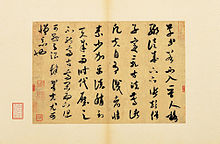
Back Chō̤-cṳ̆ CDO Konceptní písmo Czech Grasschrift German Escritura cursiva china Spanish Écriture cursive chinoise French Kurzív kínai írás Hungarian 草書体 Japanese 초서 Korean Grasschrëft LB Kinesisk kursiv stil NN
This article includes a list of references, related reading, or external links, but its sources remain unclear because it lacks inline citations. (June 2021) |
| Cursive script | |||||||||||||||||||||
|---|---|---|---|---|---|---|---|---|---|---|---|---|---|---|---|---|---|---|---|---|---|
 Mi Fu's On Calligraphy, a written discourse about the cursive style | |||||||||||||||||||||
| Chinese name | |||||||||||||||||||||
| Traditional Chinese | 草書 | ||||||||||||||||||||
| Simplified Chinese | 草书 | ||||||||||||||||||||
| Literal meaning | draft script | ||||||||||||||||||||
| |||||||||||||||||||||
| Vietnamese name | |||||||||||||||||||||
| Vietnamese alphabet | thảo thư chữ thảo | ||||||||||||||||||||
| Hán-Nôm | 草書 𡨸草 | ||||||||||||||||||||
| Korean name | |||||||||||||||||||||
| Hangul | 초서 | ||||||||||||||||||||
| Japanese name | |||||||||||||||||||||
| Kanji | 草書体 | ||||||||||||||||||||
| Cursive script | |
|---|---|
| Related scripts | |
Parent systems | Oracle bone script
|
Cursive script (Chinese: 草書, cǎoshū; Japanese: 草書体, sōshotai; Korean: 초서, choseo; Vietnamese: thảo thư), often referred to as grass script, is a script style used in Chinese and East Asian calligraphy. It is an umbrella term for the cursive variants of the clerical script and the regular script.[1]
The cursive script functions primarily as a kind of shorthand script or calligraphic style and is faster to write than other styles, but it can be difficult to read for those unfamiliar with it because of its abstraction and alteration of character structures. People who can read only standard or printed forms of Chinese or related scripts may have difficulty reading the cursive script.
- ^ "caoshu | Chinese calligraphy | Britannica". www.britannica.com. Retrieved 2022-05-03.
© MMXXIII Rich X Search. We shall prevail. All rights reserved. Rich X Search
